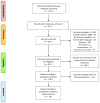The Potential of MicroRNAs as Prostate Cancer Biomarkers
- PMID: 26806656
- PMCID: PMC4927364
- DOI: 10.1016/j.eururo.2015.12.054
The Potential of MicroRNAs as Prostate Cancer Biomarkers
Abstract
Context: Short noncoding RNAs known as microRNAs (miRNAs) control protein expression through the degradation of RNA or the inhibition of protein translation. The miRNAs influence a wide range of biologic processes and are often deregulated in cancer. This family of small RNAs constitutes potentially valuable markers for the diagnosis, prognosis, and therapeutic choices in prostate cancer (PCa) patients, as well as potential drugs (miRNA mimics) or drug targets (anti-miRNAs) in PCa management.
Objective: To review the currently available data on miRNAs as biomarkers in PCa and as possible tools for early detection and prognosis.
Evidence acquisition: A systematic review was performed searching the PubMed database for articles in English using a combination of the following terms: microRNA, miRNA, cancer, prostate cancer, miRNA profiling, diagnosis, prognosis, therapy response, and predictive marker.
Evidence synthesis: We summarize the existing literature regarding the profiling of miRNA in PCa detection, prognosis, and response to therapy. The articles were reviewed with the main goal of finding a common recommendation that could be translated from bench to bedside in future clinical practice.
Conclusions: The miRNAs are important regulators of biologic processes in PCa progression. A common expression profile characterizing each tumor subtype and stage has still not been identified for PCa, probably due to molecular heterogeneity as well as differences in study design and patient selection. Large-scale studies that should provide additional important information are still missing. Further studies, based on common clinical parameters and guidelines, are necessary to validate the translational potential of miRNAs in PCa clinical management. Such common signatures are promising in the field and emerge as potential biomarkers.
Patient summary: The literature shows that microRNAs hold potential as novel biomarkers that could aid prostate cancer management, but additional studies with larger patient cohorts and common guidelines are necessary before clinical implementation.
Keywords: Cancer biomarker; Diagnosis; Prognosis; Prostate cancer; microRNA.
Copyright © 2016 European Association of Urology. Published by Elsevier B.V. All rights reserved.
Figures


Similar articles
-
Cost-effectiveness of using prognostic information to select women with breast cancer for adjuvant systemic therapy.Health Technol Assess. 2006 Sep;10(34):iii-iv, ix-xi, 1-204. doi: 10.3310/hta10340. Health Technol Assess. 2006. PMID: 16959170
-
MicroRNAs as biomarkers in spontaneous intracerebral hemorrhage: A systematic review of recent clinical evidence.Clin Neurol Neurosurg. 2022 Feb;213:107130. doi: 10.1016/j.clineuro.2022.107130. Epub 2022 Jan 14. Clin Neurol Neurosurg. 2022. PMID: 35066247
-
MicroRNA in prostate, bladder, and kidney cancer: a systematic review.Eur Urol. 2011 May;59(5):671-81. doi: 10.1016/j.eururo.2011.01.044. Epub 2011 Feb 1. Eur Urol. 2011. PMID: 21296484
-
A rapid and systematic review of the clinical effectiveness and cost-effectiveness of topotecan for ovarian cancer.Health Technol Assess. 2001;5(28):1-110. doi: 10.3310/hta5280. Health Technol Assess. 2001. PMID: 11701100
-
Signs and symptoms to determine if a patient presenting in primary care or hospital outpatient settings has COVID-19.Cochrane Database Syst Rev. 2022 May 20;5(5):CD013665. doi: 10.1002/14651858.CD013665.pub3. Cochrane Database Syst Rev. 2022. PMID: 35593186 Free PMC article.
Cited by
-
Role of noncoding RNA in drug resistance of prostate cancer.Cell Death Dis. 2021 Jun 8;12(6):590. doi: 10.1038/s41419-021-03854-x. Cell Death Dis. 2021. PMID: 34103477 Free PMC article. Review.
-
Tumor suppressive miR-99b-5p as an epigenomic regulator mediating mTOR/AR/SMARCD1 signaling axis in aggressive prostate cancer.Front Oncol. 2023 Nov 7;13:1184186. doi: 10.3389/fonc.2023.1184186. eCollection 2023. Front Oncol. 2023. PMID: 38023145 Free PMC article.
-
Exosomal miR-664a-5p as a therapeutic target biomarker for PARP inhibitor response in prostate cancer.Am J Cancer Res. 2024 Aug 25;14(8):3789-3799. doi: 10.62347/QYZS2620. eCollection 2024. Am J Cancer Res. 2024. PMID: 39267686 Free PMC article.
-
Downregulation of miR-99b-5p and Upregulation of Nuclear mTOR Cooperatively Promotes the Tumor Aggressiveness and Drug Resistance in African American Prostate Cancer.Int J Mol Sci. 2022 Aug 25;23(17):9643. doi: 10.3390/ijms23179643. Int J Mol Sci. 2022. PMID: 36077039 Free PMC article.
-
The translational potential of microRNAs as biofluid markers of urological tumours.Nat Rev Urol. 2016 Dec;13(12):734-752. doi: 10.1038/nrurol.2016.193. Epub 2016 Nov 2. Nat Rev Urol. 2016. PMID: 27804986 Review.
References
-
- Ferlay J, Steliarova-Foucher E, Lortet-Tieulent J, et al. Cancer incidence and mortality patterns in Europe: estimates for 40 countries in 2012. Eur J Cancer. 2013;49:1374–403. - PubMed
-
- Siegel RL, Miller KD, Jemal A. Cancer statistics, 2015. CA Cancer J Clin. 2015;65:5–29. - PubMed
-
- Cooperberg MR, Broering JM, Litwin MS, et al. CapSURE Investigators. The contemporary management of prostate cancer in the United States: lessons from the cancer of the prostate strategic urologic research endeavor (CapSURE), a national disease registry. J Urol. 2004;171:1393–401. - PubMed
-
- Dall’Era MA, Cooperberg MR, Chan JM, et al. Active surveillance for early-stage prostate cancer: review of the current literature. Cancer. 2008;112:1650–9. - PubMed
Publication types
MeSH terms
Substances
Grants and funding
LinkOut - more resources
Full Text Sources
Other Literature Sources
Medical

